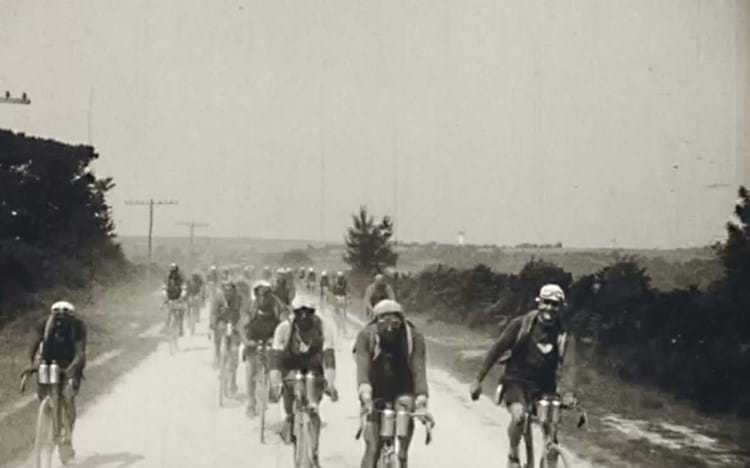
Still image from the Pathé news film of the fourth stage of the 1923 Tour de France which inspired the new book by Ned Boulting.
Image copyright:1923/Ned Boulting.
If it wasn’t learning a new language or back-to-back Netflix series, for many people lockdown in the winter of 2020 meant catching up on lots of books.
For Ned Boulting, however, the enforced period at home meant actually writing a book.

1923: The Mystery of Lot 212 and a Tour de France Obsession by Ned Boulting is published by Bloomsbury (£18.99). Available to buy now.
That work is now out, called 1923: the Mystery of Lot 212 and a Tour de France Obsession. And as the name suggests, it had its origin in another activity many people took to in lockdown, with time and unspent money to hand: bidding online at auctions.
The book covers a single day – June 30, 1923 – that marked a single stage in the arduous cycling marathon that is the Tour.
Cycling knowledge
Boulting is certainly no stranger to cycling or to writing. The sports journalist, television presenter and author has been involved with ITV’s Tour coverage since 2003.
He chatted to ATG about his ‘lockdown project’ just before heading off to commentate for ITV’s coverage of this year’s Tour, which started on July 1 (100 years and a day after the stage featured in this new book, his seventh overall).
It all started with that chance purchase at sport specialist Graham Budd’s auction in November 2020. Boulting had been tipped off to the opportunity to make an online bid by a mate who works as MC of the Professional Darts Corporation and also spends a lot of time buying sports memorabilia. Boulting is also known for darts and football coverage.
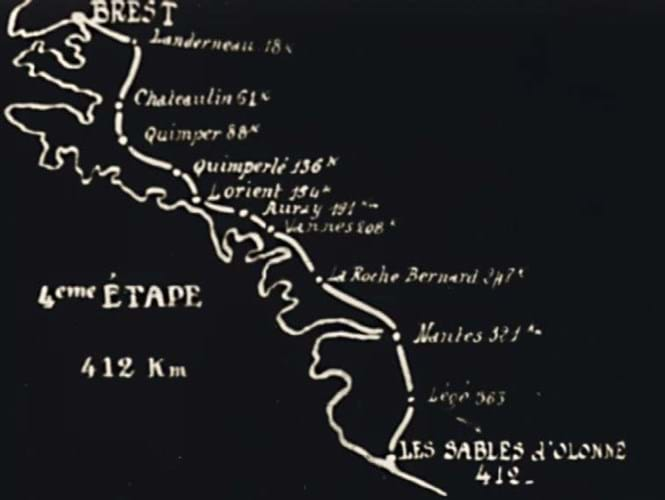
Fourth stage map from the Pathé news film of the fourth stage of the 1923 Tour de France which inspired the new book by Ned Boulting.
Image copyright:1923/Ned Boulting.
The lot estimated at £140-180 – actually numbered lot 222, however – was described partly as a ‘Tour de France b&w 35mm film reel, of fourth stage, Brest to Les Sable d’Olonne, circa 1930, first section of film includes fourth stage map’.
The description cautioned: ‘Not viewed at time of cataloguing, this lot is on a reel without a box, hence it has possibly been exposed to light, there is obvious cracking and broken areas on the first section of the film edges, we have not looked at the whole film as we have not taken it off the reel or have not looked at it through a projector.’
Boulting guessed it would prove to be a Pathé news reel and his hunch proved right. His maximum bid of £140 was enough to secure the reel and after then contacting the saleroom he gleaned it had been bought from a German auction after having previously been acquired by a French sporting memorabilia collector.
He was immediately fascinated by the two-and-a-half minute film. “The first thing you face is a very rudimentary map of the stage you are about to see, with starting and finishing point and distance, but it doesn’t say a year, just stage 4, 412km from Brest to Les Sables D’Olonne.
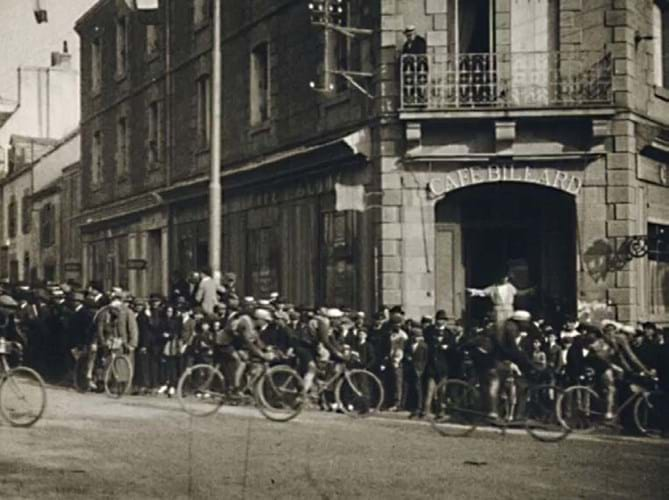
Still image from the Pathé news film of the fourth stage of the 1923 Tour de France which inspired the new book by Ned Boulting.
Image copyright:1923/Ned Boulting.
“I entered that into Google and it gave the simple response 1923, stage 4, but that wasn’t the end of the story. I didn’t know this at the time but for five years after the end of the First World War the Tour de France route was identical – of course now it changes every year. So my next confusion was that the film could have been from any one of five years and I had to figure out which one – that was hard work.”
He adds: “What I just found remarkable really is that they would have printed about a dozen of these projected news reels, shown possibly for only one or two nights in the cinemas of Paris and the major cities in France and then would have been destroyed. That’s when I realised this was worthy of deep investigation.”
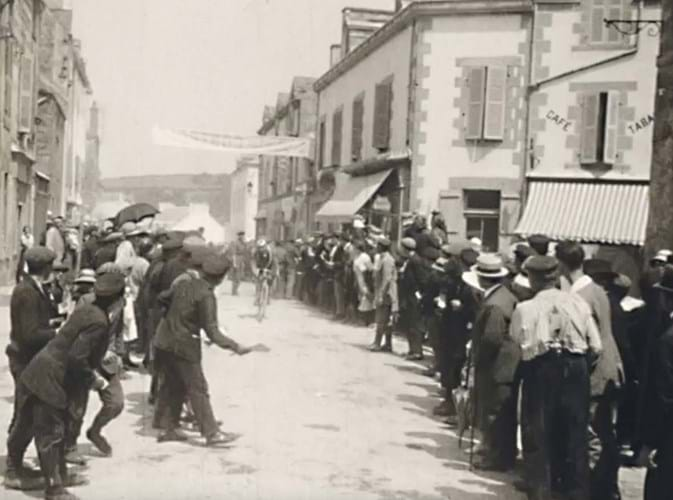
Still image from the Pathé news film of the fourth stage of the 1923 Tour de France which inspired the new book by Ned Boulting.
Image copyright:1923/Ned Boulting.
‘Escape hatch’
Not that he wished to be under such a pandemic-forced restriction, but the timing was just right.
“I knew straightaway I wanted to dive into every single corner of this film. It was a perfect lockdown project. The world was shutting down again outside and so I needed an escape hatch and the film presented me with exactly that. Day after day I disappeared upstairs and dived into the world of June 30, 1923.”
Having established the exact event shown, Boulting had another pressing difficulty to tackle, however. A rare survivor in itself given that most such reels would have been chucked in bin, the film needed tender care of a different kind: the need to be digitised.
“That was in itself not a foregone conclusion at all,” says Boulting. “The film from that era predates celluloid so it was made of nitrate. Not only is it very brittle with the passing of age but also highly combustible, something I didn’t realise at the time but subsequently was pointed out to me – that even having it in my house would have invalidated my buildings insurance. It has been known in a raised temperature to spontaneously combust.”
The film’s condition meant two to three months of sourcing the right specialist help but a facility in east London proved up to the task.
Boulting was also in a strange situation of possessing what turned out to be the only copy of this news reel in existence but with intellectual rights belonging to Pathé Cinema France. A sensible trade-off was reached with Boulting taking on the rights but Pathé then having a copy for its archives.
“I was very concerned they would look in their archives and say it turns out we’ve got five copies of this film already so don’t worry, but not a bit of it, this is definitely the only copy,” says an obviously relieved Boulting.
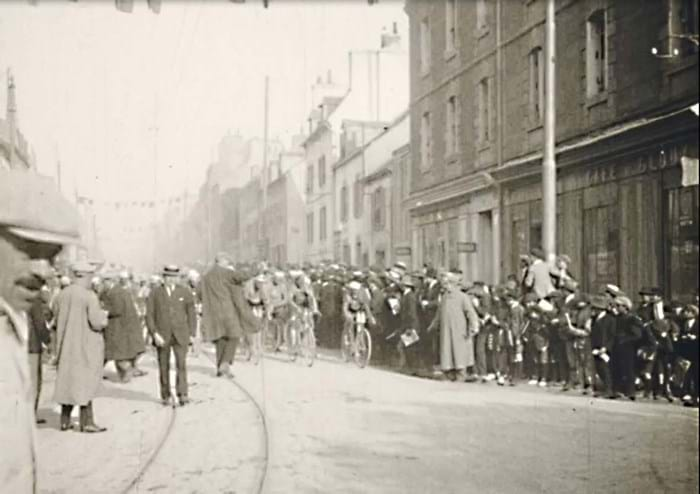
Still image from the Pathé news film of the fourth stage of the 1923 Tour de France which inspired the new book by Ned Boulting.
Image copyright:1923/Ned Boulting.
412km in one day
Many of the details of that stage in 1923 are astonishing to the modern reader. For a start, it was 412km long when today 220km or so is commonplace. The cyclists raced on gravel roads with, of course, far more rudimentary bikes and refreshments.
Even changing gear meant dismounting and using a spanner to take off the rear wheel, flip it round and put it back in again and the chain back on – and you had only two gears anyway, one for the flat and one for a mountain.
Despite concentrating on this single day of the stage, the book is much more than a simple cycling history, however, or just a memoir of his own research obsession.
Boutling says: “Once I mined the actual cycling content in the film of all I possibly could, establishing which identifiable characters are in it, reading around their biographies, then my eye got distracted and I started to see what was going on in France and Europe on that day and over that summer and that’s when the project started to balloon out of all proportion.
“It started to take on the elephantine proportions that it has done because the political and cultural landscape of June 30, 1923, was absolutely fascinating. I am not a historian but I started to behave like a historian and tentatively started to reach a loose conclusion that actually that summer was the ‘end’ of the First World War, the afterglow of that conflict.
“It was being consigned to history and the starting pistol for the Second World War was being fired, a pivotal moment in European history for all sorts of reasons. All playing out in the background of this day of racing that was caught on film.”

The film’s mention of Théo Beeckman, who became central to Ned Boulting’s book on the fourth stage of the Tour de France in 1923.
Image copyright:1923/Ned Boulting.
The story took on a very personal nature – one that became a central theme in fact – when Boulting looked closely at a part of the reel which namechecked a particular rider: Brusquement, Beckman s’echappe et passe seul au viaduct de Laroche-Bernard (‘Suddenly Beckman escapes and crosses the viaduct… alone’)
The obsession focused on this one rider, Théo Beeckman (research not helped by the fact that the name Beeckman had been spelt wrong).
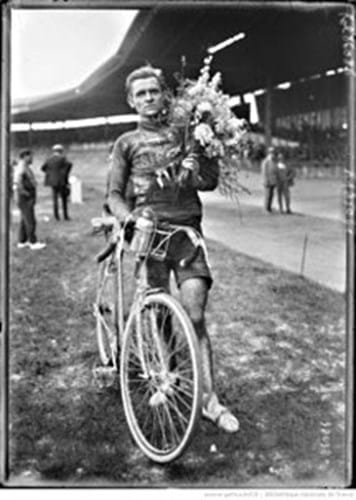
Théo Beeckman.
Image copyright: Bibliothèque de France
Boulting says: “I imagine you could ask 100 cycling enthusiasts across the world whether they had heard of him and not a single one would say yes because he a was very, very good rider without being one of the greats. He went on to win two stages of the Tour de France and finished just off the podium so he was a notable rider but for whatever reason his story has been entirely forgotten.
“Even in the cycling-fanatical town he lived all his life in east Flanders, which is the heart of professional road racing, no one has heard of him.”
The exhaustive research paid off and Boulting was able to not just uncover Beeckman himself but track down and meet the family and descendants – “Even among them there is almost nothing known about what their grandfather got up to… they knew vaguely he was a racing cyclist but didn’t even know he’d competed in the Tour de France.
“I ended up in the odd position of being the only person on the planet that knew about him. It felt like a curious responsibility to keep someone’s memory alive like that, becoming another big mission of mine that came randomly from this film.”
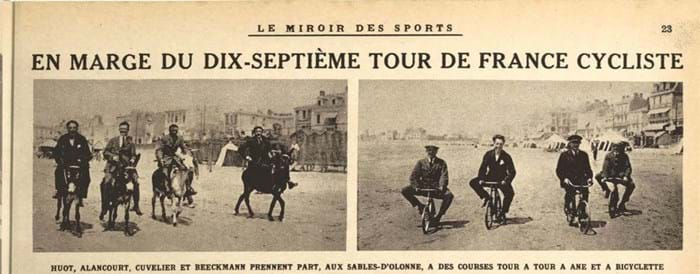
Boulting unearthed this remarkable newspaper report depicting Théo Beeckman and fellow riders relaxing on the beach after the stage.
Image copyright:1923/Ned Boulting
Gruelling challenge
Boulting’s attention now is on the 2023 edition of the Tour but his lockdown project which took on a life of its own has clearly given him a new perspective on this gruelling event.
Any chance of another book born out of an auction purchase (but not in another lockdown we hope)?
“I’d love to think so, but I can’t imagine unearthing anything of that mystery again, unique and wonderful. I don’t think an old jersey or a cycling cap from the 1950s would quite have that hefty resonance. I will keep an eye out for sure but I think it was a real one-off.”















